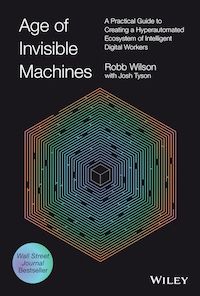Co-creation is the secret sauce of hyperautomation. It’s critical to get your team trending away from the land of centralization and silos and toward the co-creation mindset — because, while it’s true that certain Intelligent Digital Workers (IDWs) will only serve certain departments, their evolution is a company-wide endeavor.
7 Essential Roles for a Core Enablement Team
- Strategic liaison
- Lead experience architect
- Conversational experience designer
- Data analyst/architect/visualization
- Technical architect/developer
- Quality assurance
- Human-in-the-loop
This is where your core enablement team comes in: their mission is to get people involved in the creation and evolution of the skills in your company’s ecosystem. The core enablement team will guide your whole organization as the creators and keepers of your strategy.
This team will facilitate the process used to create experiences that align with your strategy. They should be exemplary teachers and collaborators. Choose your team wisely — they’ll be the ones helping others in the organization build patterns, steps and toolkits to manage their own IDWs successfully.
Strategic Liaison (SL)
This is the hardest role to define in traditional terms, but this person is the cornerstone to the success of the whole endeavor. The strategic liaison creates value for their organization through their intimate understanding of how to match-make the needs of various internal business groups with their organization’s ecosystem strategy. They’re the glue that binds winning teams around a vision and resources needed to realize it. They know the possibilities of the ecosystem and work to shape and evangelize hyperautomation throughout the organization.
There are no rules dictating who the right person is for this role, but ideally they’re a peer or trusted influencer to top-level leaders and decision-makers in the organization.
Lead Experience Architect (LXA)
Responsible for facilitating, generating, and executing great user experiences, this role is many things. The quality and consistency of experiences offered by skills published in your company’s shared library are under this person’s purview. This leadership role demands a true veteran of human-centered design, interaction design, and design research. Acting as a coach, mentor, and lead through the process, the LXA works to map the journey for interacting with skills and IDWs in close harmony with the core-enablement team, and conversational experience designers in particular.
Bringing experiences to life while empowering business groups to create more and more without depending on the core-enablement team is the LXA’s jam. This person has the crucial duty of building and managing the road map of skills being created and improved upon by the core-enablement team in collaboration with various business groups.
Conversational Experience Designer (XD)
A conversational experience designer takes high-level requirements and turns them into flows that support the right experience. In a way, the rest of the team is a support mechanism enabling this role. XDs can be anyone in any department, they don’t need to have development experience but should have great communication and problem-solving skills. They should be versed in conversational design principles and have a strong enough command of your building platform that they can train others on using it.
Data Analyst/Architect/Visualization (DA)
Measuring outcomes, insights, and predictions is critical to getting experiences tuned just right. Having someone architecting and designing processes for measuring success and gaining insight into each interaction with your digital workers is key.
Technical Architect/Developer (TA/D)

This role understands the development platform on a technical level and can build customs or library steps, views, and cards that enable XDs to build any skill needed. This person should always be thinking of building in a shareable, modular way. No-code software creation happens when users can build using modular pieces that are made up of granular, low-level functionalities sequenced together.
This presents a new paradigm for traditional developers — one that breaks free from the constraints associated with coding in a vacuum. The TA/D will become a trusted advisor, as someone who understands how skills are structured and who can fine-tune on a micro level and advise all the way up to the macro. They will also get to spend more time doing the actual writing of code.
Quality Assurance (QA)
This role is key to success, and this person needs outstanding customer interfacing skills. Running a test plan often involves user testing and load testing. QA should be capable of running functional testing and should also understand specific principles in automated testing and test planning.
Human-in-the-Loop (HitL)
Human-in-the-loop (HitL) is many things: a tool, a design pattern, and a role within the core enablement team. The relationship that develops between IDWs and humans-in-the-loop is the fertilizer that accelerates growth. HitL is a powerful, fluid role with the ability to bind and strengthen your entire ecosystem.
If that sounds like a superhero bio, then my description is on target. Anyone within your organization can become a human-in-the-loop when the situation calls and then recede into the background once they’ve helped an IDW complete an interaction. HitL is powerful: when someone assumes the role, they leverage knowledge, perspective, and experience surrounding a task that they have a deep understanding of, which fills the gaps and accelerates training for IDWs.
A Unified Front
Putting these patterns I’ve outlined to work for your organization requires a unified front with everyone in your organization contributing their strengths. Hyperautomation efforts hinge on the effectiveness of your core-enablement team — the people who facilitate all aspects of hyperautomation and, more importantly, get everyone in your organization comfortable creating and improving their own automations.
No matter what your industry, leveraging a core enablement team by embracing this approach will allow you to move more quickly than your competitors. Assigning core enablement team members and supporting them can make the difference between success and failure.
Excerpted with permission from the publisher, Wiley, from Age of Invisible Machines: Creating a Hyperautomated Ecosystem of Intelligent Digital Workers by Robb Wilson with Josh Tyson. Copyright © 2023 by Robb Wilson. All rights reserved.





